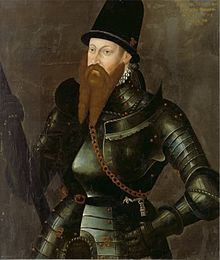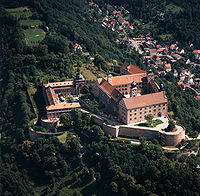Siege of Kulmbach and the Plassenburg
The siege of Kulmbach and the Plassenburg took place in 1553 as part of the Second Margrave War and led to the destruction of the city in November 1553 and the handover of the castle in June 1554. In the following months, the Plassenburg was also destroyed.
Starting position
Main article: Second Margrave War
Margrave Albrecht Alcibiades of Brandenburg-Kulmbach (1522–1557) took over the government in the Principality of Brandenburg-Kulmbach in 1541 . Albrecht was widely feared as a warlord and mercenary leader and is considered to be the inventor of the light cavalry tactics that were used until after the Thirty Years' War. He unleashed the Second Margrave War with the attempt to establish a Duchy of Franconia at the expense of the bishops of Bamberg, Würzburg and Eichstätt, as well as the imperial cities of Nuremberg , Schweinfurt and others .
As early as April 1, 1552, Albrecht published a leaflet in which he denounced the abuses prevailing in the empire as well as the division of faith and outlined the emperor's wrong policies. Albrecht wrote of the necessity that the princes had to restore order to the empire, that he himself wanted to act in order to preserve the " Teutsche Libertät ". In the summer of 1552 he besieged Nuremberg, which in the contract of June 19, 1552 bought itself free with 200,000 guilders and declared its accession to the Princes' League. Albrecht took action against the Franconian dioceses at the same time and conquered the Bamberg fortress town of Forchheim during the siege of Nuremberg .
On May 9, 1553, an alliance was formed between the Elector Moritz von Sachsen , Duke Heinrich von Braunschweig and Bishops Weigand von Redwitz and Melchior Zobel von Giebelstadt . In June the Franconian bishops, united with the imperial city of Nuremberg, managed to occupy the entire lower land of the margraviate. On July 9th, south of Hanover near Sievershausen, the first major battle broke out between Albrecht and his former ally, Elector Moritz von Sachsen, who had come to the aid of the Duke of Brunswick. Albrecht was defeated in the battle of Sievershausen and the way was clear for the federal armies to march into the Upper Mountain principality of the margrave. Moritz von Sachsen was badly wounded and died after the battle.
The siege

Since Elector Moritz von Sachsen had died in the battle of Sievershausen , King Ferdinand of Bohemia took over command of the armies of Albrecht's enemies. On August 1, 1553, Bohemian troops invaded the Sechsämterland . Within a short time, the entire Principality of Albrecht was in the hands of its enemies. On November 22, 1553, the ring of siege closed around the margravial residence town of Kulmbach . Heinrich IV von Plauen and Haug von Parsberg were among the leaders of the besiegers. The bombardment caused severe damage to the medieval city wall. When the troops of the federal estates under the command of Duke Heinrich von Braunschweig-Wolfenbüttel began to storm the city on the day of Saint Konrad , November 26, the margrave troops set Kulmbach on fire. A woodcut by the Nuremberg artist Hans Glaser from 1553 shows the burning Kulmbach on November 26th, 1553. Under the orders of Joachim von Zedtwitz , the soldiers found refuge in the Plassenburg , the civilian population was turned away and had to flee to neighboring principalities or found themselves in unsafe refuge in the surrounding forests. The Duke of Braunschweig ordered his soldiers not to let any male residents of the city live.
A contemporary source reports: “Then in average the Braunschweygischer war people / came to the Brinnende city / and what they first seriously gripped by the warriors / also otherwise by Man's people / stabbed there ... But on the flying Reutter and Knecht / has the Hertzog three Gschwader Reutter decreed / chase the inen / what they should catch / stab and stab. "
This order, which was also extraordinary for the 16th century, is probably due to the fact that three of the Brunswick's sons were killed in the fight against Albrecht Alcibiades. This siege and the sad events are commemorated in Kulmbach on Konraditag to this day.
Already in June 1554, Margrave Albrecht lost his last battle near Schwarzach near Kitzingen . The Plassenburg ob Kulmbach, the state fortress of the Principality of Brandenburg-Kulmbach , capitulated on June 22nd. It initially served as a central collection point for the chattels looted in the principality, which were then distributed to the individual parties. The Bamberg bishop secured the house archive of the Hohenzollern family, which he had brought to Bamberg, as a pledge for his claims against Albrecht Alcibiades. The fortress was not destroyed until months after it was pillaged by the federal states. Margrave Albrecht was given the imperial ban and died outlawed in 1557 with his sister in Pforzheim . His principality was ruled by imperial sequesters .
In 1557 the Hohenzollern family got Kulmbach back with the Plassenburg and Margrave Georg Friedrich became the new lord of the "Land auf dem Gebürg".
Diorama in the tin figure museum
The siege of Kulmbach and the Plassenburg is shown in the German Tin Figure Museum with the largest diorama in the world. In the Obermain Landscape Museum , a film and some exhibits show the horrors and technical complexity of the siege. The siege, destruction and reconstruction of the city and castle are also discussed in the Hohenzollern Museum on the Plassenburg.
See also
swell
- Georg Thiel: Siege of the city of Kulmbach 1553. Diary of the court preacher Georg Thiel about the siege of Kulmbach and the Plassenburg during the Federal War . Copy in the city archive of Kulmbach.
- Eight-page leaflet from 1554 from the Kulmbach city archive with the title: True display / what the masses the city of Colmbach has conquered / and burned. Kulmbach city archive, without signature.
- Karl Heinrich Lang: Modern history of the principality of Baireuth, second part from the year 1527 to the year 1557, Göttingen 1801 .
literature
- Daniel Burger : The state fortresses of the Hohenzollern in Franconia and Brandenburg. In: Die Plassenburg, series of publications for local research and cultural maintenance in East Franconia. Kulmbach 2000.
- Otto Kneitz: Albrecht Alcibiades, Margrave of Kulmbach 1522–1557 in: The Plassenburg, series of publications for local research and cultural maintenance in East Franconia . Kulmbach 1951.
- Hellmut Kunstmann : Burgen am Obermain with special appreciation of the Plassenburg in: Die Plassenburg, series of publications for local research and cultural maintenance in East Franconia, volume 36 . Kulmbach 1975
- Fritz Limmer: Reports on the destruction of the Plassenburg in the so-called federal or margravial wars in 1554 in: Nachrichten des Verein Freunde der Plassenburg 6, 1934 .
- Sabine Weigand : The Plassenburg - residence function and court life until 1604 . Weißenstadt 1995.
- Johannes Voigt: Margrave Albrecht Alcibiades of Brandenburg-Kulmbach , Berlin 1852, 2 volumes.
- Johann Wilhelm Holle : History of the siege of the Veste Plassenburg from November 27, 1553 to June 22, 1554 . In: Archives for history and antiquity of Upper Franconia . 1st volume, 2nd issue. Bayreuth 1840. pp. 28-69.
Web links
credentials
- ^ Voigt, Johannes: Margrave Albrecht Alcibiades von Brandenburg-Kulmbach, Berlin 1852, Volume I, pp. 284 ff.
- ↑ Otto Kneitz: Albrecht Alcibiades, Margrave of Kulmbach 1522–1557 , p. 86 f.
- ↑ http://www.landschaftsmuseum.de/Bilder/Konradi-2.jpg
- ↑ Eight-page leaflet from 1554 from the Kulmbach city archives with the title: True display / what masses the city of Colmbach has conquered / and burned . Kulmbach City Archives, without signature, p. 3
- ^ Preger Wilhelm: Textbook of Bavarian History, 15th edition, Erlangen & Leipzig 1900, p. 76 ff.

